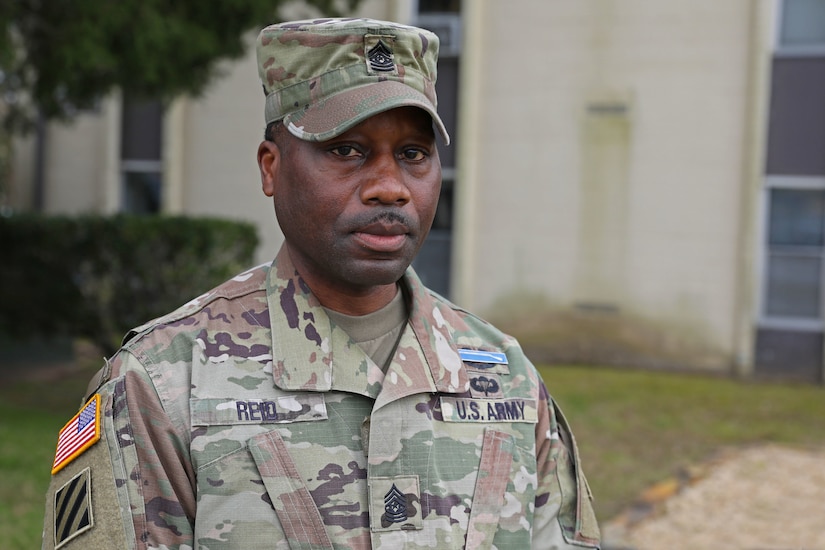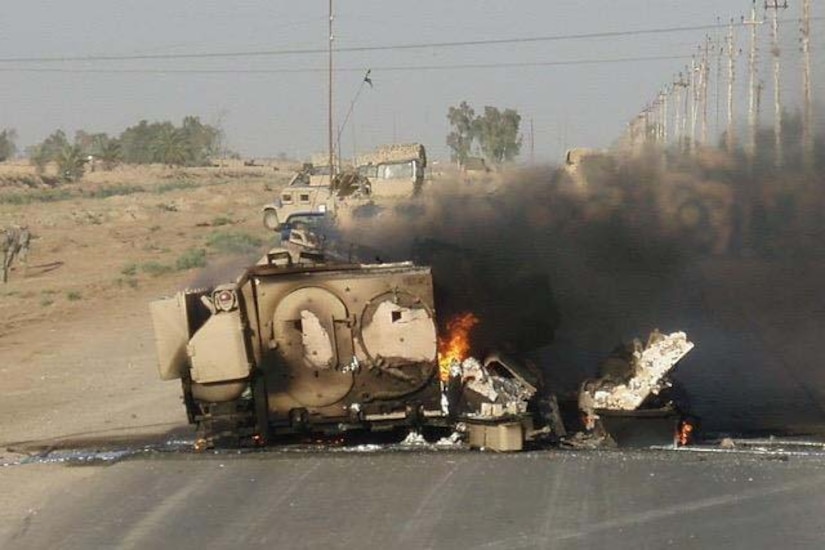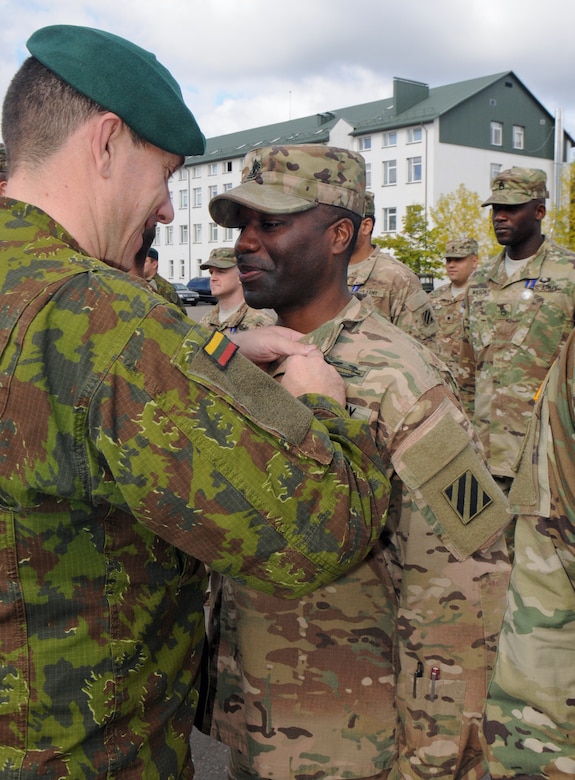April 30, 2021 |
Curtis Reid was 33 years old when his heart stopped.
It happened in a dusty building southeast of Baghdad. He was surrounded by soldiers he loved.
"I watched him die," recalls Lyndon Kilcrease, then a newly-promoted Army specialist. "They started to resuscitate him, and I remember Jones saying 'Look, he's dead.'" But Reid would live to serve on.

It was July 3, 2006. Reid's unit had just returned from an overnight air assault mission that involved clearing insurgents out of a local village. Kilcrease remembers the soldiers returning to their base — Combat Outpost Cahill — around 5:00 a.m.
"We were all bone tired," he said. Most of the members of the unit weren't aware that a change occurred overnight that would send the weary soldiers back out into harm's way later that morning. The soldiers were originally set to bring their vehicles in for refit July 4. However, there was a change in orders, and now they would be bringing them to Forward Operating Base Hammer — some 50 miles away — a day early.
"So, we got ready and loaded up the Bradleys with the dismounts," remembers Reid.
With the dismounted soldiers loaded into the back of the vehicle, Reid told his driver to raise the back ramp, but the ramp didn't budge, so the soldiers manually closed it.
First their mission to go for refit was bumped forward a day and now the ramp on their vehicle was broken. Reid remembers thinking this seemed like a sign.
With the ramp finally locked in place, the line of vehicles departed COP Cahill and headed toward FOB Hammer. Reid's vehicle was the last in line and was tasked with providing rear security. The 25mm cannon on his Bradley faced toward the back of the vehicle.
"The back deck has a cargo hatch," Reid said. "Dismounts can get in and out of the cargo deck, but if that barrel is blocking that cargo hatch, you can open it but you can't get out."
"Once we hit a certain checkpoint, we proceeded, and, the next thing I know, it's just a huge explosion; it shattered my helmet," said Reid. "I just remember calling out 'IED, IED, IED' and I looked over at my gunner, and he was knocked out, unconscious." [IED stands for improvised explosive device.]

Reid recalls that the vehicles in front of him turned around immediately after the explosion and medics rushed to his vehicle.
"I'm kind of in shock and disarray, and that's when I pulled my gunner out and took him to the ground," Reid said. "The medics were already there on scene. My driver had managed to get out of his hatch. He was hit with shrapnel and was on fire."
Reid's driver for the day was Kilcrease, whose recollection of the explosion is hazy.
"I remember us driving, and then I remember 'boom' and then there's, like, a brief 30 seconds or a minute that I was knocked out," said Kilcrease. "I woke up and there was just fire everywhere. The [explosively formed penetrator] went off, and it went through the fuel cell; then, it went through the engine; then, it blew into the driver's compartment right behind me."
EFPs were a common weapon used by insurgents to penetrate the thick armor of military vehicles. They work by focusing a weighted piece of metal in an explosion and can cause high levels of destruction on impact.
After Kilcrease woke up, he turned around and looked in the area behind the driver's seat, dubbed the 'hell hole.'
"I tried to release the back ramp so that the guys in the back could get out," said Kilcrease. "There's a lever; it's the ramp lever. It releases the emergency hatch so you can push the button to lower the ramp. After I turned around and saw the hell hole was on fire, I grabbed the release. I tried to push the ramp button down, but all the electronics had been knocked out of the Bradley, so nothing was working."
With the ramp malfunctioning, Kilcrease exited the burning vehicle. He was on fire when he hit the ground and was tackled by a medic who put out the flame.

Reid remembers watching the medics treat Kilcrease. It was at this moment that he realized that the dismounts were trapped inside with a malfunctioning ramp and the gun blocking the top exit to the vehicle.
"I knew that if I didn't do anything, they would burn alive in there," Reid said. "From that point, I jumped back into the turret in my compartment. In the Bradley, you control the turret in mechanical mode or electric mode; I put everything in manual mode. Once I did that I was able to raise the gun barrel."
Reid lifted the gun barrel to maximum elevation, and a soldier in the back of the vehicle popped the hatch open halfway.
"I jumped out of the turret to where the cargo hatch was and opened up the cargo hatch all the way," Reid said. "I jumped into the hull to where the dismounts were in the back, where they ride at. I took each individual out one by one and also the Iraqi interpreter. Some of them were unconscious, some of them were just confused from the explosion, so they didn't have any idea what happened."
After getting the last soldier out of the vehicle, Reid jumped off the burning Bradley. Hitting the ground is the last thing he remembers.
"His adrenaline went out, and he just collapsed," said Kilcrease.

Reid's next memory is of waking up in a small hospital. It was here where his heart stopped and the medical team resuscitated him. The medics treated Kilcrease alongside him.
"They're scrubbing me down trying to control all these burns and pulling shrapnel," he said. "They put [Reid] on a litter right in front of us. He quit breathing."
"They resuscitated him and got him back," Kilcrease said. "I can't tell you how I felt at the time. I was just sitting there watching a dude that you kind of looked at as a father figure die."
Reid's next stop was in Landstuhl, Germany, where a medical team worked to stabilize him. The explosion ruptured his spleen, so the doctors removed it. Once he was out of critical condition, he was moved to Womack Army Hospital at Fort Bragg, North Carolina, for recovery.
While the physical injuries were painful, the concussion caused neurological injuries that last to this day.
"I had to go through speech therapy, writing therapy, hand and eye coordination therapy," Reid said. "It was like a two-year rehab. Sometimes, I still have challenges with speaking."

Reid's leadership presented him with the Silver Star Medal during his recovery at Womack.
Reid's recovery was grueling, but he said that his faith, his family, and his love for the soldiers he served with kept him pushing to get better. These injuries might have ended the careers of other soldiers, but, for Reid, they were just hurdles to overcome.
"I love being around soldiers," Reid said. "That's why I'm still doing what I do, because I love being around soldiers and taking care of soldiers."






No comments:
Post a Comment